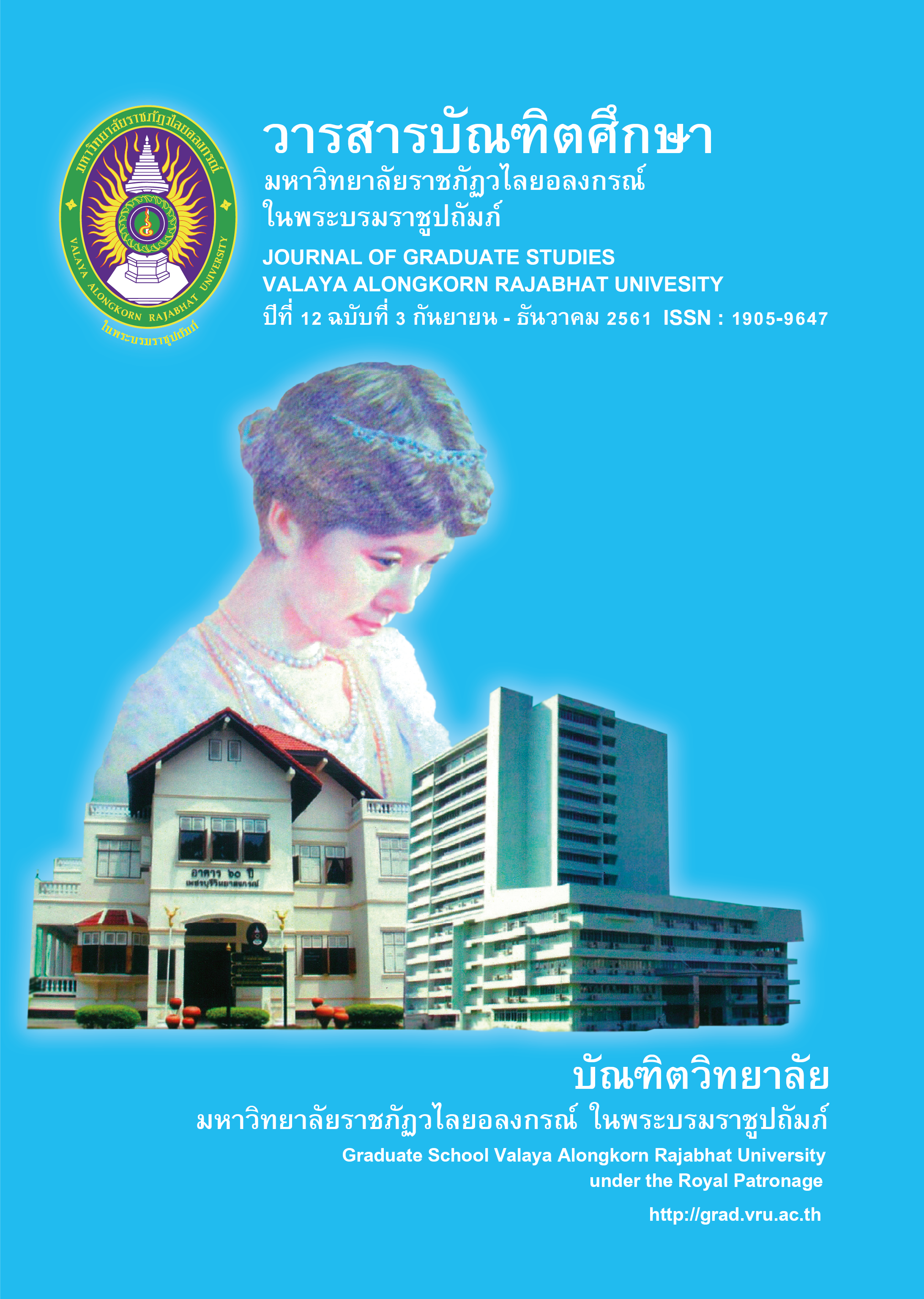EFFECTS OF CLEANER TECHNOLOGY MANAGEMENT ON COMPETITIVE ADVANTAGE AND ORGANIZATIONAL SUSTAINABILITY OF THE ELECTRICAL AND ELECTRONICS EQUIPMENT BUSINESS
Main Article Content
Abstract
The objective of this research was to 1) Study about cleaner technology management, competitive advantage and organizational sustainability, 2) Test the effect of cleaner technology management on competitive advantage, 3) Test the effect of cleaner technology management on organizational sustainability, and 4) Test the effect of competitive advantage on organizational sustainability of Electrical and Electronic Equipment Business. Data were collected from 340 Electrical and Electronic Equipment Business executives by using stratified random sampling method and using a questionnaire as a research tool. Statistics used for data analysis were mean, standard deviation and multiple regression analysis.
The findings revealed that the executives of the Electrical and Electronic Equipment Business had opinions about cleaner technology management overall and individual aspects include the high level of reduction of pollution sources, reuse, and conservation of resources and energy. The executive strongly agreed about cleaner technology management. The also strongly agreed about each dimensions as of reduction of polluted resources, reuse and the conservation of resource and energy. They strongly agreed about the competitive advantage and the dimension as of the efficiency, the quality, innovation and customer responsiveness. They strongly agreed about organizational sustainability and the dimension as of firm reliability, corporation image, financial security and reputation.
According to analyses of the data in term of relations and effects, it was found that 1) the dimension of cleaner technology management as of reduction of polluted resources, reuse and the conservation of resource and energy had positive relationship and affect to competitive advantage, 2) the dimension of cleaner technology management as of reduction of polluted resources, reuse and the conservation of resource and energy had positive relationship affect to organizational sustainability, 3) the dimension of competitive advantage as of the quality, innovation and customer responsiveness had positive relationship affect to the organizational sustainability.
Article Details
บทความทุกเรื่องได้รับการตรวจความถูกต้องทางวิชาการโดยผู้ทรงคุณวุฒิ ทรรศนะและข้อคิดเห็นในบทความวารสารบัณฑิตศึกษา มหาวิทยาลัยราชภัฏวไลยอลงกรณ์ ในพระบรมราชูปถัมภ์ มิใช่เป็นทรรศนะและความคิดของผู้จัดทำจึงมิใช่ความรับผิดชอบของบัณฑิตวิทยาลัย มหาวิทยาลัยราชภัฏวไลยอลงกรณ์ ในพระบรมราชูปถัมภ์ กองบรรณาธิการไม่สงวนสิทธิ์การคัดลอก แต่ให้อ้างอิงแหล่งที่มา
References
กรมโรงงานอุตสาหกรรม. (2554). ข้อมูลโรงงานอุตสาหกรรม. สืบค้นจาก www.diw.go.th/diw/query.asp.
กรมส่งเสริมอุตสาหกรรม. (2555). ข้อมูลอุตสาหกรรมไฟฟ้าและอิเลกทรอนิกส์. สืบค้นจากhttps://strategy.dip.go.th/ข้อมูลอุตสาหกรรมไฟฟ้าและอิเลกทรอนิกส์/tabid/93/Default.aspx.
กระทรวงอุตสาหกรรม. (2545). แนวคิดเทคโนโลยีสะอาด Clean Technology . วารสารกรมส่งเสริมอุตสาหกรรม. 10-23.
การปิโตเลี่ยมแห่งประเทศไทย. (2552). เทคโนโลยีสะอาดเปลี่ยนโลกการผลิตสู่ความยั่งยืน. วารสารสื่อพลัง. 17(3), 52.
เกรียงศักดิ์ เจริญวงศ์ศักดิ์. (2550). การสร้างความยั่งยืนขององค์กรธุรกิจ. สืบค้นจาก https://www.oknation.net.
ชาคริต สุขเจริญ. (2551). การศึกษาการใช้เทคโนโลยีสะอาดเพื่อลดต้นทุนการผลิตในกลุ่มอุตสาหกรรมพื้นฐานประเภทโรงแต่งแร่. วิทยานิพนธ์วิศวกรรมศาสตร์มหาบัณฑิต สาขาวิชาวิศวกรรมการจัดการอุตสาหกรรม มหาวิทยาลัยพระจอมเกล้าพระนครเหนือ.
บุญชม ศรีสะอาด. (2556). การวิจัยเบื้องต้น. พิมพ์ครั้งที่ 9. กรุงเทพ : บุญศิริการพิมพ์.
เยาว์ แรงการ. (2551). ผลกระทบของการใช้เทคโนโลยีสะอาดที่มีผลต่อการดำเนินงาน กรณีศึกษา : อุตสาหกรรมยานยนต์แห่งประเทศไทย. วิทยานิพนธ์บัญชีมหาบัณฑิตบริหารธุรกิจ มหาวิทยาลัยธรรมศาสตร์.
วิทยา ด่านธำรงกุล. (2546). การบริหาร. กรุงเทพฯ : เธิร์ดเวฟเอ็ดดูเคชั่น.
ศิริวรรณ เสรีรัตน์. (2547). ศัพท์การบริหารธุรกิจ. กรุงเทพฯ : โอเอส.พริ้นติ้งเฮาส์.
ศิลปะพร ศรีจั่นเพชร. (2560). การบัญชีตามความรับผิดชอบต่อสังคม. วารสารวิชาการบริหารธุรกิจ. 6(1), 25-32.
สถาบันไฟฟ้าและอิเลกทรอนิกส์. (2555).Structure of Thailand E&E Industry. สืบค้นจาก https://www.thaieei.com:90/SiteAssets/pages/viewpage5/Thailand_and_Industry.pdf.
สถาบันไฟฟ้าและอิเลกทรอนิกส์. (2560). รายงานสถานการณ์อุตสาหกรรมเครื่องใช้ไฟฟ้าและอิเลกทรอนิกส์ ปี 2560. สืบค้นจาก https://eiu.thaieei.com/box/Outlook/44/รายงานสถานการณ์เดือนม.ค.60%20ข้อมูลพ.ย.59.pdf.
สมยศ นาวีการ. (2547). การบริการและพฤติกรรมองค์การ. กรุงเทพฯ : บรรณากิจ 1991 จำกัด.
สรินทร ลิ่มปนาท. (2554). เทคโนโลยีสะอาด. สืบค้นจาก www.material.chula.ac.th.
เสนาะ ติเยาว์. (2549). หลักการบริหาร. พิมพ์ครั้งที่ 3. กรุงเทพฯ : มหาวิทยาลัยธรรมศาสตร์.
เสาวลักษณ์ โงชาฤทธิ์. (2555). ผลกระทบของการจัดการเทคโนโลยีสะอาดที่มีผลต่อการดำเนินงานของธุรกิจสิ่งทอในประเทศไทย. วิทยานิพนธ์เศรษฐศาสตร์มหาบัณฑิต สาขาวิชาเศรษฐศาสตร์ มหาวิทยาลัยมหาสารคาม.
Getzner, M. (2002). The Quantitative and Qualitative Impacts of Clean Technologies on Employment. Journal of Cleaner Production. 10(4), 305-319.
Guan, Jian Cheng and others. (2006). A Study of the Relationship between Competitiveness and Technological Innovation Capability based on DEA Model. European Journal of Operational Research. 170(3), 971.
Lovett, H. T. (2002). The effect of violating the Assumption of Equal Item Means in Estimation the Livingstone Coefficient. Education and psychological Measurement. 38(1978), 239 – 251.
Nunnally, J. C. (1978). Psychometric Theory. New York: McGraw – Hil.
Porter, Michael E. (2005). The Competitive Advantage Creating and Sustaining Superior Performance. New York: The Free Press.
Yaw, F. Jr. (2004). Clean Technologies as an Aspect of Sustainable Tourism: Carribbean Case Studies. Dissertations. 4.
Zwetsloot, Gerard I. J. M. (2000). Improving Cleaner Production by Intergration in to the Management of Quality Envoronment and Working Conditions. Journal of Cleaner Production. 3(1-2), 61-66


